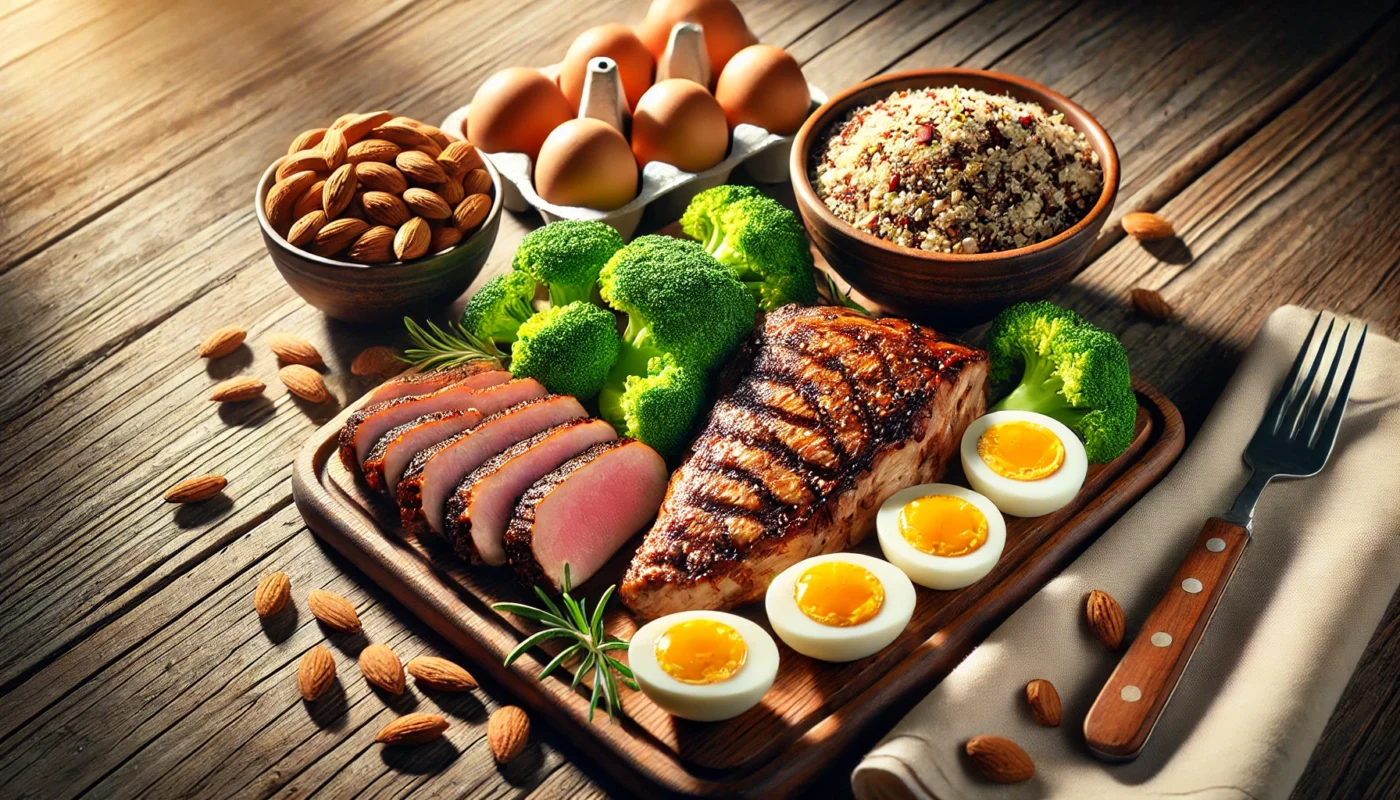Building muscle quickly is a goal shared by many, whether you’re a fitness enthusiast, a health seeker, or a medical patient looking to improve your physical condition. While the journey to increased muscle mass involves dedication and effort, there are several scientifically-backed strategies that can accelerate your progress. In this article, we’ll explore the best ways to build muscle mass quickly, focusing on the role of protein, calories, and exercise.
You may also like: High Protein Foods to Fuel Workouts

Understanding Muscle Growth
Muscle growth, or hypertrophy, occurs when muscle fibers are subjected to stress, such as resistance training, causing them to adapt and grow. The process involves the repair of muscle fibers, which requires an adequate supply of nutrients, particularly protein and calories.
The Physiology of Muscle Hypertrophy
Muscle hypertrophy begins at the cellular level, where resistance training induces micro-tears in muscle fibers. These micro-tears signal the body to repair and fortify the muscle, leading to increased size and strength. This repair process is dependent on amino acids, the building blocks of protein, highlighting the crucial role of nutrition.
Importance of a Balanced Nutrient Supply
A balanced supply of macronutrients—protein, carbohydrates, and fats—is essential for muscle growth. Carbohydrates replenish glycogen stores, providing the energy needed for intense workouts, while fats support hormone production and overall cellular health. A deficit in any macronutrient can impede muscle repair and growth.
Hormonal Influence on Muscle Growth
Hormones such as testosterone, growth hormone, and insulin-like growth factor (IGF-1) play significant roles in muscle growth. These hormones promote protein synthesis and muscle hypertrophy. Resistance training has been shown to naturally elevate levels of these hormones, enhancing muscle development.
The Role of Protein in Muscle Growth
Protein is the building block of muscle tissue. It provides the essential amino acids needed for muscle repair and growth. Studies have shown that increased protein intake can enhance muscle hypertrophy, particularly when combined with resistance training.
Daily Protein Requirements
The amount of protein needed can vary based on factors like age, sex, and activity level. General recommendations suggest consuming 1.6 to 2.2 grams of protein per kilogram of body weight for optimal muscle growth. It’s important to distribute protein intake evenly across meals to maximize protein synthesis.
Timing of Protein Intake
Timing protein intake around workouts can significantly influence muscle repair and growth. Consuming protein within the anabolic window—30 minutes to 2 hours post-exercise—can enhance recovery and muscle protein synthesis. Pre-workout protein can also provide amino acids during exercise.
Quality of Protein Sources
The quality of protein sources is crucial for muscle growth. Animal-based proteins are complete, containing all essential amino acids, while plant-based proteins might require combinations to achieve a complete amino acid profile. The digestibility and absorption rate of proteins also affect their effectiveness.
Best Protein to Increase Muscle Mass
Different types of protein can affect muscle growth differently. Whey protein, for instance, is a popular choice among athletes because of its high biological value and rapid absorption rate. Casein, on the other hand, is absorbed more slowly, making it ideal for periods of fasting, such as overnight.
Whey Protein: Fast Absorption
Whey protein is derived from milk and is known for its rapid absorption, making it ideal for post-workout consumption. Its high leucine content—a key amino acid for muscle protein synthesis—makes it particularly effective for muscle growth.
Casein Protein: Slow Release
Casein protein is also derived from milk but digests more slowly, providing a sustained release of amino acids. This makes it suitable for consumption before long fasting periods, like sleep, ensuring a continuous supply of nutrients for muscle repair.
Plant-Based Protein Options
For those seeking alternative sources, plant-based proteins like pea and soy can also be effective, although they might require combining with other protein sources to achieve a complete amino acid profile. Blends of different plant proteins can provide a balanced amino acid composition.
Protein vs. Calories for Muscle Gain
While protein is crucial, calories also play a significant role in muscle growth. To build muscle, you must be in a caloric surplus, meaning you consume more calories than your body burns. This surplus provides the energy needed for protein synthesis and muscle repair.
Establishing a Caloric Surplus
To create a caloric surplus, increase your daily caloric intake by 250 to 500 calories. This gradual increase helps prevent excessive fat gain while still providing enough energy for muscle growth. Monitoring calorie intake ensures you’re consuming enough to support muscle repair and growth.
Balancing Macronutrient Ratios
While in a caloric surplus, it’s essential to balance macronutrient ratios to optimize muscle growth. Aim for a diet comprising approximately 40-60% carbohydrates, 25-35% protein, and 15-25% fat. This balance supports energy needs, muscle repair, and overall health.
Monitoring Progress and Adjustments
Regularly monitor your progress through methods like body composition analysis or tracking strength gains. If muscle growth plateaus, consider adjusting caloric intake or macronutrient ratios. Personalized adjustments ensure continued progress and prevent unwanted fat gain.

Does Calories or Protein Build Muscle?
A balance between protein intake and calorie consumption is essential. Consuming excessive calories without adequate protein might lead to fat gain rather than muscle growth. Conversely, high protein intake with insufficient calories might inhibit muscle repair and growth.
The Synergy of Protein and Calories
Protein and calories work synergistically to promote muscle growth. Protein provides the building blocks for new muscle, while calories supply the energy necessary for synthesis. Both are vital components of an effective muscle-building diet.
Risks of Imbalanced Intake
An imbalance in protein and calorie intake can lead to suboptimal results. Overconsumption of calories without enough protein can result in fat accumulation, while high protein intake without adequate calories can lead to muscle loss due to insufficient energy.
Strategies for Optimal Balance
To achieve an optimal balance, calculate your daily caloric needs and macronutrient requirements. Use tools like food diaries or apps to track intake and ensure you’re meeting your protein and calorie goals. Regular adjustments based on progress can fine-tune your approach.
Effective Training Strategies
Resistance Training
Resistance training is the cornerstone of muscle growth. It involves exercises that cause the muscles to contract against an external resistance, like weights, resistance bands, or bodyweight exercises. Progressive overload, or gradually increasing the weight or resistance, is key to continuous muscle growth.
Types of Resistance Training
There are various forms of resistance training, including free weights, machines, and bodyweight exercises. Each type has its benefits and can be combined to create a comprehensive training regimen. Free weights offer a greater range of motion, while machines provide stability and isolation.
Importance of Progressive Overload
Progressive overload is the gradual increase of stress placed on the muscles during training. This can be achieved by increasing weights, repetitions, or intensity over time. Consistently challenging muscles through progressive overload is essential for continued growth and strength gains.
Balancing Volume and Intensity
Training volume (sets and reps) and intensity (weight lifted) are critical factors in muscle growth. A balance between the two is necessary for optimal results. High volume with moderate intensity is often recommended for hypertrophy, while lower volume with higher intensity targets strength gains.
Strength vs. Muscle Gain Requirements for Protein
Strength training focuses on increasing the ability to exert force, whereas muscle hypertrophy training focuses on increasing muscle size. Both require adequate protein intake, but hypertrophy typically demands a higher overall volume of training and protein consumption.
Differentiating Training Goals
Understanding the difference between strength and hypertrophy goals is crucial. Strength training emphasizes lifting heavier weights with fewer repetitions, while hypertrophy training focuses on moderate weights with higher repetitions to increase muscle size.
Protein Needs for Strength Training
Strength training requires sufficient protein to repair and build muscle fibers, but the overall protein demand may be slightly lower than for hypertrophy. A focus on quality and timing of protein intake can support strength gains effectively.
Protein Strategy for Hypertrophy
Hypertrophy training demands higher protein intake to support increased muscle volume. Consuming protein at regular intervals throughout the day ensures a constant supply of amino acids, maximizing muscle protein synthesis and growth.
High-Intensity Interval Training (HIIT)
HIIT involves short bursts of intense exercise followed by rest or low-intensity periods. This method can enhance muscle endurance and stimulate growth. Incorporating HIIT with resistance training can maximize muscle gain while improving cardiovascular health.
Benefits of HIIT for Muscle Growth
HIIT offers several benefits for muscle growth, including increased metabolic rate and enhanced cardiovascular fitness. The intense nature of HIIT workouts stimulates muscle fibers differently than traditional resistance training, potentially promoting additional growth.
Combining HIIT with Traditional Training
Integrating HIIT with traditional resistance training can optimize muscle growth and overall fitness. HIIT sessions can be added to rest days or as a finisher after resistance workouts to boost endurance and caloric expenditure without compromising muscle recovery.
HIIT for Time-Efficient Workouts
HIIT is ideal for those with limited time, as it provides effective workouts in shorter durations. A typical HIIT session lasts 15-30 minutes, offering an efficient way to burn calories and stimulate muscle growth. Its flexibility allows it to be tailored to individual fitness levels.
Nutritional Strategies for Muscle Growth
Best Type of Protein for Muscle Growth
The best type of protein depends on individual dietary preferences and needs. Animal-based proteins like chicken, beef, and fish are complete proteins, providing all essential amino acids. For vegetarians and vegans, combining different plant proteins can ensure a complete amino acid profile.
Animal-Based Protein Sources
Animal-based proteins are often considered superior for muscle growth due to their complete amino acid profiles. Lean meats, dairy products, and eggs are excellent sources that provide high-quality protein necessary for muscle repair and growth.
Plant-Based Protein Solutions
For vegetarians and vegans, combining plant-based proteins, such as beans, lentils, and quinoa, can create a complete amino acid profile. Supplementing with protein powders from sources like pea, soy, or rice can also ensure adequate protein intake.
Adjusting Protein Sources Based on Goals
Individual goals and dietary preferences should guide protein source selection. Those seeking rapid muscle growth might prioritize high-leucine animal proteins, while those focused on sustainability might choose plant-based options. Tailoring protein sources can align with ethical or lifestyle choices.
Do You Need to Eat More to Gain Muscle?
Yes, consuming more calories than you expend is crucial for muscle growth. However, it’s important to focus on nutrient-dense foods that provide both macronutrients and micronutrients essential for overall health and muscle function.
Importance of Nutrient-Dense Foods
Choosing nutrient-dense foods ensures you meet your caloric and nutritional needs without excessive calorie intake. Foods rich in vitamins, minerals, and antioxidants support muscle function, recovery, and overall health, optimizing your muscle growth journey.
Meal Frequency and Timing
Eating smaller, more frequent meals can help meet caloric needs and maintain steady energy levels. Consuming balanced meals every 3-4 hours ensures a constant supply of nutrients for muscle repair and growth, preventing catabolism during fasting periods.
Monitoring Caloric Intake
Tracking caloric intake helps ensure you’re in a surplus conducive to muscle growth. Tools like food diaries or apps can assist in monitoring consumption, allowing for adjustments to align with muscle-building goals and prevent unwanted fat gain.
Supplements for Muscle Growth
While whole foods should be the primary source of nutrients, supplements can aid in achieving muscle growth goals. Popular supplements include:
Creatine: Enhancing Strength and Mass
Creatine is one of the most researched and effective supplements for increasing strength and muscle mass. It works by supplying additional energy to muscle cells, enhancing performance during high-intensity workouts, and promoting muscle growth.
Branched-Chain Amino Acids (BCAAs): Recovery Support
BCAAs—leucine, isoleucine, and valine—are crucial for muscle recovery and reducing exercise-induced soreness. They can be consumed before or after workouts to enhance muscle repair, particularly during calorie deficits or fasting periods.
Beta-Alanine: Performance Booster
Beta-Alanine is known to improve exercise performance by buffering acid in muscles, delaying fatigue during high-intensity exercise. It can increase lean body mass by enabling longer and more intense training sessions, contributing to muscle growth.
Recovery and Rest
Adequate rest and recovery are vital components of muscle growth. Muscles need time to repair and grow after workouts, making sleep and active recovery days essential.
Importance of Quality Sleep
Sleep is a critical factor in muscle recovery, with 7-9 hours per night recommended for optimal results. During sleep, the body releases growth hormone, which facilitates muscle repair and growth, emphasizing the importance of establishing a consistent sleep routine.
Hydration for Recovery
Proper hydration is essential for muscle recovery and performance. Water supports nutrient transport, joint lubrication, and temperature regulation, all crucial for effective workouts and recovery. Aim for consistent hydration throughout the day.
Incorporating Active Recovery
Active recovery involves low-intensity exercises like yoga, walking, or swimming, which promote blood flow and nutrient delivery to muscles. Incorporating these activities on rest days can aid in recovery without hindering muscle growth, maintaining flexibility and mobility.

Conclusion
Building muscle quickly requires a multifaceted approach that includes proper nutrition, strategic training, and adequate recovery. By understanding the roles of protein and calories, utilizing effective training techniques, and optimizing recovery, you can accelerate your muscle growth journey. Whether you’re a fitness enthusiast, health seeker, or medical patient, these strategies can help you achieve your muscle-building goals efficiently.
Remember, consistency is key. With dedication and the right approach, significant muscle gains are within your reach. Keep pushing, stay informed, and enjoy the process of transforming your body.
HIIT, resistance training, muscle growth, protein sources, nutritional strategies, caloric intake, supplements, recovery, active recovery, hydration, fitness, workout efficiency, nutrient-dense foods, meal timing, exercise performance, strength training
Further Reading:
10 Muscle-Building Fundamentals You Need to Learn
How to build muscle with exercise
What You Should Know About Building Muscle Mass and Tone
Important Note: The information contained in this article is for general informational purposes only, and should not be construed as health or medical advice, nor is it intended to diagnose, prevent, treat, or cure any disease or health condition. Before embarking on any diet, fitness regimen, or program of nutritional supplementation, it is advisable to consult your healthcare professional in order to determine its safety and probable efficacy in terms of your individual state of health.
Regarding Nutritional Supplements Or Other Non-Prescription Health Products: If any nutritional supplements or other non-prescription health products are mentioned in the foregoing article, any claims or statements made about them have not been evaluated by the U.S. Food and Drug Administration, and such nutritional supplements or other health products are not intended to diagnose, treat, cure, or prevent any disease.

